If you are a customer of Clallam PUD, and want to buy some solar electricity, but can’t install solar on your own house, you should look into their newly announced Community Solar project. You should probably sign up sooner rather than later because I anticipate this project will be fully subscribed very quickly. This project will be a 30 KW ground-mounted installation in downtown Sequim.
The PUD is offering shares equivalent to 15 watts of solar capacity each for about $60. Individal PUD customers can buy up to 125 shares. The project has a guaranteed 25 year life. The project will be installed by the end of the year, the details as to the equipment or any installation contractor have not been determined. The details are on their website here: https://www.clallampud.net/communitysolar/
At $4 per watt, the shares are roughly equivalent to the price for our roof mounted pv projects, so if you own a home and could afford to do at least a 5 KW system, you should consider installing on your own house rather than participating in this program. However the Community Solar project is ideal if you can not put solar on your own home, or if you have already filled your own roof with solar panels and are not yet making 100% of your own clean energy.
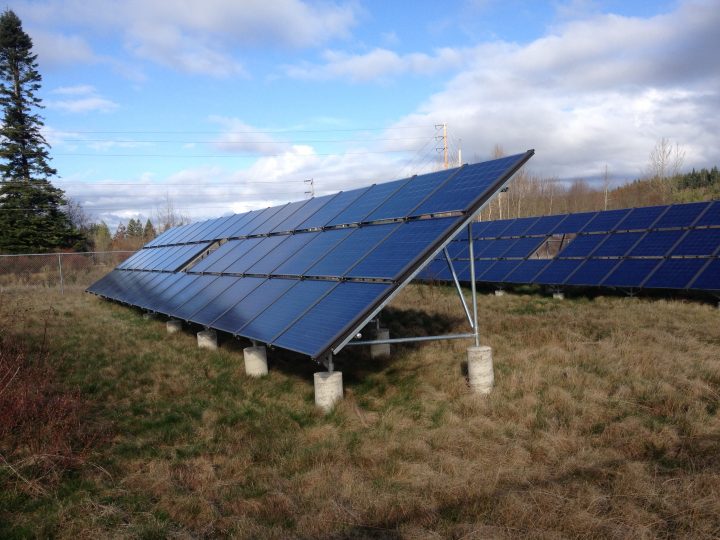
17 KW Community Solar Array, Jefferson Intl Airport, Port Townsend, 2011
by Andy Cochrane | Apr 17, 2019
SunPower has been our favorite PV manufacturer for years. They offer the highest efficiency, highest quality, leading technology, cleanest manufacturing process, and the best warranty in the industry. Now they are offering a $1000 donation to the Sierra Club and a $1000 rebate for Homeowners on new projects.
At Power Trip Energy, we will handle the design and installation of your project, and we handle all of the paperwork for your net metering interconnection with the utility, and this rebate program. Ask us for details when you schedule your site evaluation.
While the federal government debates the Green New Deal, and our state considers a 100% Renewable Energy Portfolio Standard, you can take action now in your own home to make your own clean electricity. When people lead, the leaders follow.
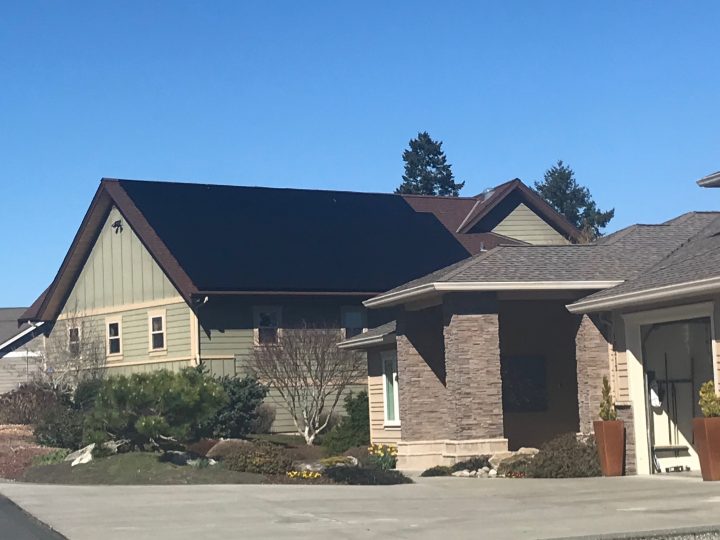
14 KW SunPower AC Modules, Keyport, WA, March 2019
by Andy Cochrane | Mar 21, 2019
It is important to update our state’s Net Metering law, originally passed in 1998, to reflect the current state of the market and protect homeowners’ investments in their home. The new bill would raise the cap from 0.5% to 4% and provide a path for continued investment. SB is sponsored by Sen Palumbo, and recently passed the Senate, now for consideration by the house.
We sent a letter to Sen. Van de Wege thanking him for his vote.
Subject: Thank you for supporting the Solar Fairness Act (Senate Bill 5223)
Body:
Dear Sen Van de Wege,
I appreciate your yes vote on the Solar Fairness Act to pass it out of the Senate last week.
As you know, our clients are counting on the state’s protection for the fair value of their solar electricity. That protection and guarantee of reliable fair compensation from utilities give us the ability to give the needed peace of mind to our clients while they are considering this investment in clean energy for their home and our community.
Please consider me your resource whenever I can be of any assistance to your office in matters relating to solar energy.
Best regards,
Andy Cochrane
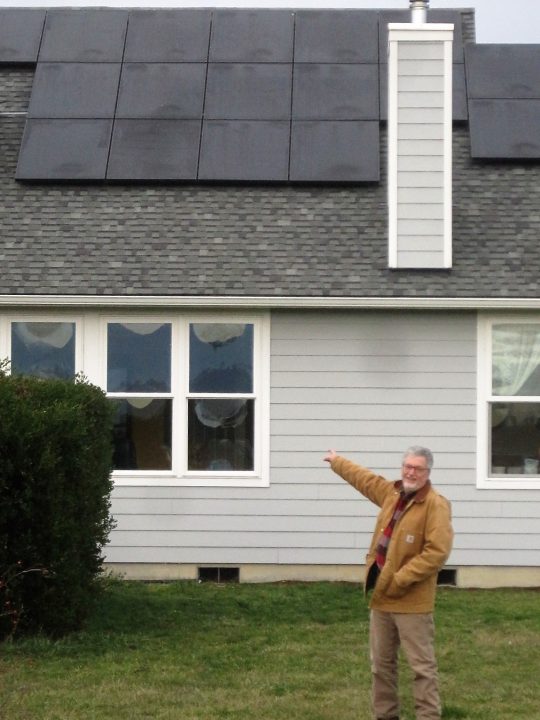
by Andy Cochrane | Mar 11, 2019
This year in Olympia is a “short session” for our part-time legislature. Solar Washington has published a summary of the various energy-related bills, several of which have the potential to make significant progressive steps for our state. I encourage you to take a look and see which of these bills might excite you to contact your representatives. https://www.solarwa.org/washington_solar_legislation
SSB (Senate Substitute Bill) 5223 is the bill that affects homeowners considering grid-tied solar PV systems most directly by increasing the threshold of the net metered capacity required of utilities from 0.5% to 4% of the 1996 peak load. We have exceeded the current threshold in every utility district on the Olympic Peninsula, and we have seen one regressive utility mired in some backsliding that has a negative impact on our clients. This bill would incur no costs to the state or utilities and would remove the potential for impediments which discourage individuals from investing in clean energy for their homes and communities.
I encourage you to read and support this improvement to our state’s net metering, which will bring our thresholds into the 21st century.
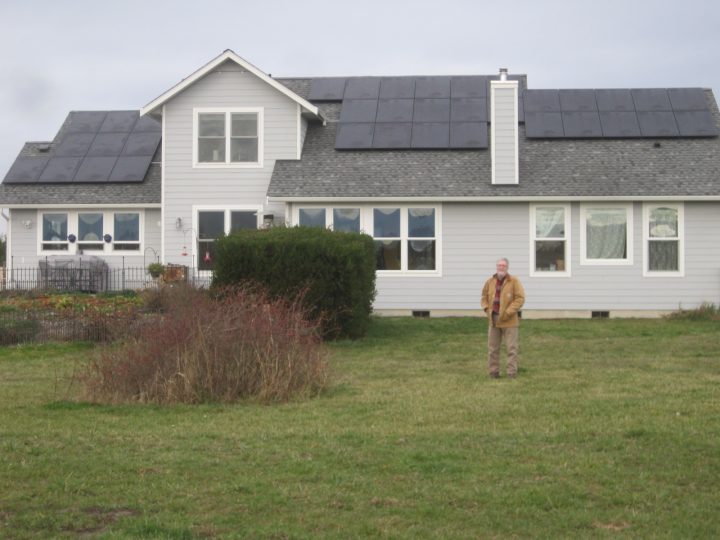
11.7 KW SunPower array – Sequim – December 2018
by Andy Cochrane | Feb 6, 2019
Get a free Dewalt lithium yard tool of your choice or EV charging equipment when you order a solar array in the month of February.
If you are like me, you love being in your yard. Most of our clients spend a fair amount of time and energy to create beauty, perhaps grow some tasty food, and generally work to make their yards into nice outdoor spaces in which to spend time. At my place, it takes a whole lot of work to maintain that space, which I mostly enjoy, but it involves the use of some tools I don’t love. When you are outdoors you may hear a neighbor running a gasoline mower, a weed whacking string trimmer, or perhaps a landscape service running a leaf blower or hedge trimmer.
Even the use of a relatively clean four stroke engine results in the burning of gasoline and the resulting noise and pollution. At my home, I recently added a couple of lithium battery-powered electric yard tools. Some of the ones I looked at a couple of years ago seemed expensive and underpowered, but this year, one tool in particular changed my mind and has set me on the path of electric mowing and trimming.
A friend bought a DeWalt electric lithium chainsaw. I laughed to myself at first, but my mind quickly changed when he dropped a couple of trees in his woodlot. It seemed every bit as powerful as my Stihl two stroke chainsaw. True, the battery only lasted enough to cut a couple of trees, so it will not be replacing gas-powered chainsaws for professional lumberjacks anytime soon, but it seems fine for a homeowner that may use a chainsaw for maintenance and clean up or cutting a couple of trees at a time.
That motivated me to try out the new lithium electric DeWalt string trimmer and I was very impressed. I can run it for over an hour on a single charge, and that is plenty of time weed whacking at once for me at my place. Shortly after that we got a Ryobi mower and a DeWalt hedge trimmer for heavier brush cutting. These tools all work very well and fulfill my goals of keeping my yard maintained while not burning gas.
In the past, we have run specials wherein we include the installation of Electric Vehicle charging equipment at no cost with a new solar array. Getting an electric vehicle is probably the biggest change you can make concurrent with installing solar to decrease your carbon emissions. This summer, we are now going to run a special to encourage you to switch to a cleaner way of maintaining your yard.
When you order a solar pv array 4 KW or larger in the month of July, we will throw in your choice of DeWalt electric lithium mower, or a package including one DeWalt string trimmer and one hedge cutter.
If you order a larger system of 12 KW or more in the month of July, we will give the choice of either all three of those yard tools, or a Clipper Creek LCS-25 Electric Vehicle charging station (including installation.)
This offer expires July 31st.
Of course our main goal is to install solar on your home, but we also want to do everything we can to make sure we use that clean power for all we can. While there are complications and disagreements regarding the science and politics of climate change, in general we feel there are indisputable benefits to this goal:
Electrify everything, and make sure that electricity is carbon free.
To learn more, please give us a call or come on one of our upcoming solar home tours.

A – DeWalt lithium cordless 13” String Trimmer and 22” Hedge Trimmer Package (# DCST920B820P1)

B – DeWalt lithium cordless mower (# DCMW220P2)

C – Clipper Creek LCS-25 Level II EV Charging Station
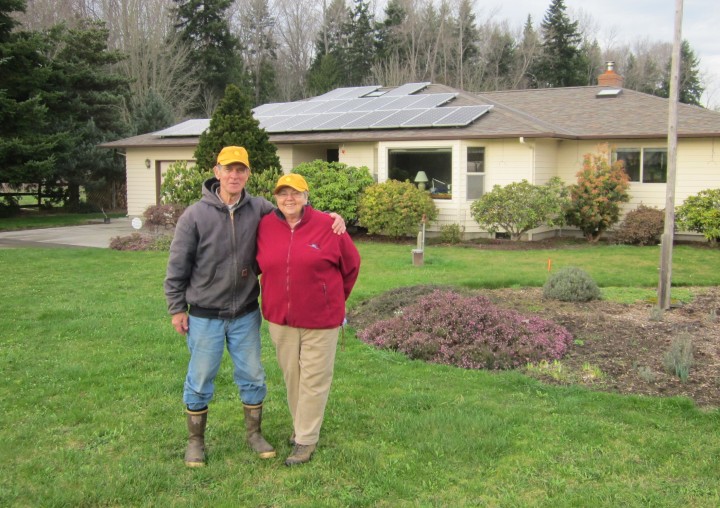
by Andy Cochrane | Jan 23, 2019
We have the opportunity to address the impacts of carbon pollution in a positive and innovative way by passing Initiative 1631 this election. By putting a fee on carbon, initially $15 per metric ton of carbon pollution, then reinvesting that money in clean energy, this program uses economic tweaks to make inefficient and dirty practices more expensive and give clean technology and practices an advantage.
The funds that are collected through the carbon fees from the largest polluters are designated for clean energy projects and habitat restoration on state lands. These will gradually have positive impacts to decrease and mitigate our state’s contribution to climate change, while providing positive economic stimulation and creating new clean energy jobs.
The program will encourage a decrease in carbon pollution, but it does not dictate steps for polluters to decrease their emissions. Washington will see innovation in clean energy technologies, leveraging our existing entrepreneurial culture and high tech work force. This is good for everybody in the state, except the petroleum industry and a few other major polluters.
Perhaps that is why the 12 largest contributors to the No on 1631 campaign are out of state petroleum companies that have donated over $21 million to defeat this initiative – including Phillips 66, BP, Chevron, Valero, and Koch Industries.
1631 specifically requires that 35 percent of the fees collected will go back to low-income communities to help decrease energy costs. All investments will overseen by a public board made up of community leaders and experts in science, business, and health, so that energy companies and special interests aren’t making decisions about our future.
I feel no doubt that more carbon pricing is coming to the US in the near term. Europe’s Emissions Trading System was the first and remains the largest Cap and Trade program in the world, now over 12 years in existence. Mandatory programs in the US currently include California’s Cap and Trade program in existence for 5 years, and the mandatory market-based Regional Greenhouse Gas Initiative, which includes 9 Northeastern states.
Initiative 1631 is a much simpler and more directly effective measure, and I hope we can seize this opportunity here in Washington.
The economics of carbon are coming one way or another in our near future – we can either lead, follow, or get run over by more innovative states. I choose to lead, and Initiative 1631 is the tool we need right now.
yeson1631.org
References:
California Cap and Trade – https://www.arb.ca.gov/cc/capandtrade/capandtrade.htm
Regional Greenhouse Gas Initiative – https://www.rggi.org/
Public Disclosure Commission showing campaign contributions – https://www.pdc.wa.gov/browse/campaign-explorer/committee?filer_id=NO1631%20507&election_year=2018
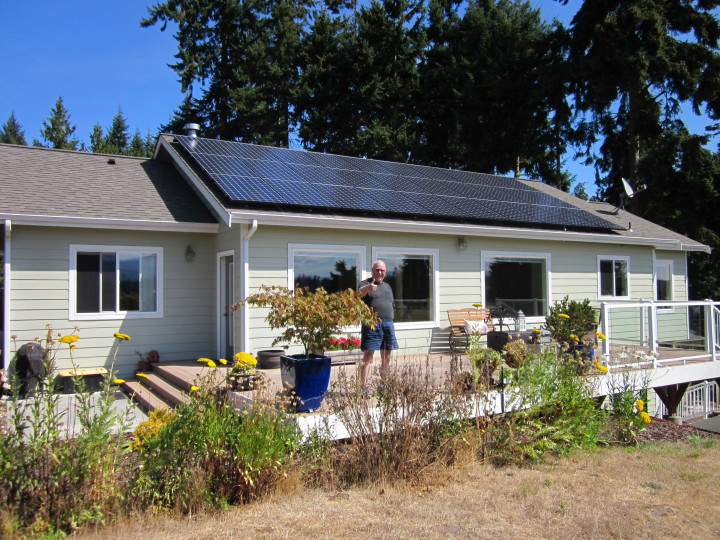
by Andy Cochrane | Oct 15, 2018
The Clallam PUD board of commissioners has taken the step of publicly opposing Initiative 1631, citing increased operating costs and higher gasoline prices as reasons for opposition. Clallam County PUD officials say the carbon fee initiative would increase the district’s annual fuel and shipping costs by $20,000 in 2020 and by $51,000 by 2035. Clallam PUD’s revenue is about $75 million per year, so the initial $20,000 projected increase in 2020 amounts to approximately 0.027% of the PUD’s revenue.
The PUD Commissioner Simpson also reportedly was concerned about negative impacts to the PUD from a wider adoption of electric vehicles. “There’s impact on any utility of upgrading their system to accommodate the charging of batteries for electric cars,” Simpson said.
We suggest the PUD Commissioners look at the migration from gasoline to electricity as major transportation fuel as an opportunity to increase PUD revenues and decrease money leaving the community through gasoline expenditures. No gasoline or diesel is created in Clallam County, whereas there are over 750 roof top solar arrays producing clean electricity. Expansions in electrical generation will result in positive local economic activity and prevent money leaving the community for polluting fossil fuels. The increased revenues can be re-invested in our public electrical infrastructure. The PUD’s job is to help navigate to a more advantageous position in a cleaner future, not to oppose any change due to fear of increased costs without a vision of the benefits of capturing more of the energy economy locally.
We see many benefits of cutting out petroleum and carbon based industries, while capturing those revenues locally and building a cleaner future. This is the reason we stand with hundreds of businesses, tribes, unions, and faith-based organizations in favor of 1631. Learn more about this initiative here http://yeson1631.org
Why is Clallam PUD siding with the petroleum industry in opposition to a carbon fee? Could they better represent their ratepayers by focusing on the most beneficial way to move forward toward a cleaner future?
peninsuladailynews.com/politics/clallam-pud-opposes-carbon-fee-initiative/
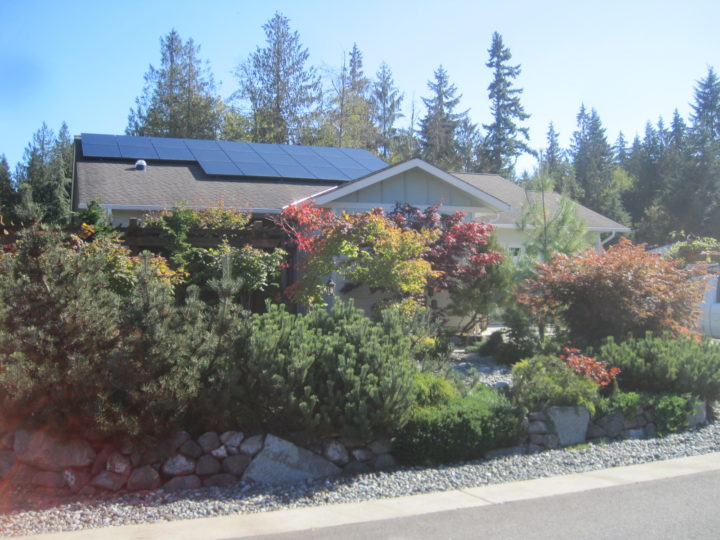
8 KW of SunPower, Port Angeles, 2017
by Andy Cochrane | Oct 3, 2018
SunPower, a California based company that makes their PV cells in the Philippines, has been subject to the same solar tarriffs as the rest of the industry, despite arguing that they were materially different from the cheap commodity imports, protection from which was the point of the tarriffs. SunPower has been paying $2 million per week in tarriffs, which they say could have been better spent on research and development here in the US.
Today they received notice that the tariffs would not be applied to their “inter-digitated back contact” (IBC) Maxeon cells, which are in the most efficient solar modules on the market.
There are two other big recent news item from SunPower:
They have announced a 5 year strategic partnership with Enphase, the worlds largest micro-inverter manufacturer. SunPower had been manufacturing their own micro-inverters since their purchase of SolarBridge several years ago, and have sold that facility to Enphase, who will use it to expand their own production capabilities. The Enphase micro-inverters will be incorporated into SunPower’s AC modules for products we receive beginning in the fourth quarter of this year.
Secondly, SunPower’s purchase of SolarWorld Americas is closing soon, and in this, SunPower has purchased the largest North American manufacturing location and will produce their own product as well as the SolarWorld modules for the German parent company.
As the solar market matures, we see complexity and consolidations, and we are very happy to see SunPower taking the steps it needs to remain a global leader in solar manufacturing. We have been SunPower dealers since 2008, and we appreciate their highest efficiency, strongest warranty, and stable market position. They now comprise nearly 100% of our installations.
https://solarindustrymag.com/sunpower-announces-solar-tariff-exemption/.
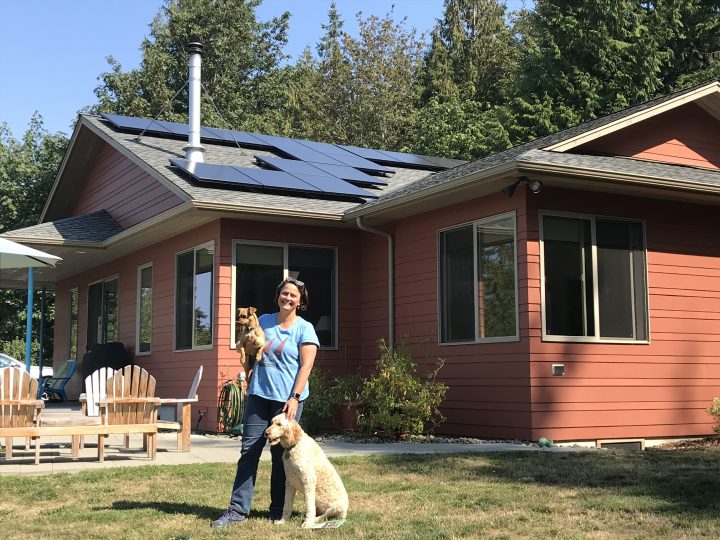
11.4 kw in Port Townsend, working around some tree and chimney shading with SunPower modules.
by Andy Cochrane | Sep 18, 2018
Solar is Sexy, Financing Is Not Sexy
Unless you are in the business of helping people put a solar array on their homes, you might not think much about some of the other things that have to line up for these projects to make sense. The technology itself is fairly straightforward, but some other significant factors that support these projects are:
- Utility policy and the state laws that allow or prevent obstruction of solar installation
- Natl. Electric Code that supports solar photovoltaic (PV) equipment and provides guidance for safe installations
- Federal tax policy recognizing the value of clean energy
- State laws preventing HOA’s from interfering with the installation of solar
- Sensible loan packages in the case someone needs outside financing
Here in Washington State, we are blessed with a confluence of these factors that all come together making the installation of solar PV relatively attractive for our clients. At this moment I would especially like to give appreciation to two local credit unions for putting together some very low interest energy efficiency financing programs, and the WA State Dept of Commerce, which has implemented a program enabling these loans in partnership with the credit unions.
Until a few years ago, we did not have any attractive credit options to recommend for our clients. The only option our state’s solar industry had was consumer credit along the lines of how you might finance an appliance, perhaps from GE Capital, and those loans were not anything we would ever recommend to our clients. Within the last couple of years however, we now have some excellent low interest rate, long term financing designed specifically for these projects and some of the other incentives they receive.
Both Puget Sound Cooperative Credit Union and Generations Credit Union have received high reviews from our clients that have used these loans. The rates are low and the terms are variable to work with your needs. The key is that each of these loans is supported through a loan guarantee from WA Dept of Commerce, and each is structured to work specifically with other available incentives in order to maximize the economic benefits of the solar electricity being made on your roof.
At this point, nearly 1/3 of our customers are using financing from one of these two credit unions. Puget Sound Cooperative Credit Union has let us know they are writing solar loans for solar at the pace of of $2 Million per month. That is a lot of solar here in Washington State, and that is a big turn on.
So for some of us solar geeks, financing actually can be sexy. Links to each credit union’s program is below.
https://www.psccu.org/Borrow/Energy-Smart-Loans.aspx
https://www.generationscreditunion.com/solar-cash-flow-loan.htm
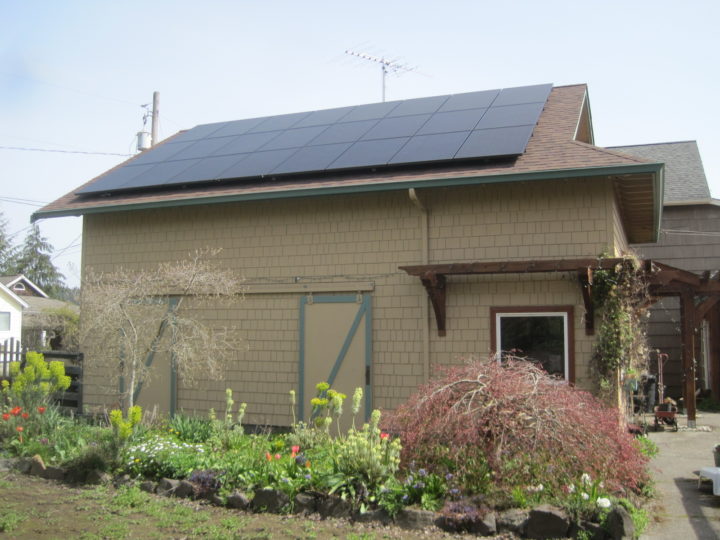
by Andy Cochrane | Jun 7, 2018
As more people purchase the economical Electric Vehicle models that are increasing their range and becoming an obvious choice of new car, we are also getting asked a lot more about using those batteries for your house or also the Vehicle-to-Grid concept (V2G). There have also been several recent articles talking about developments in V2G technology, and the concept is interesting – “as long as I have a 40 kwh lithium battery in my car which is parked in my garage, I think it would be a good to idea use that battery for powering my house.”
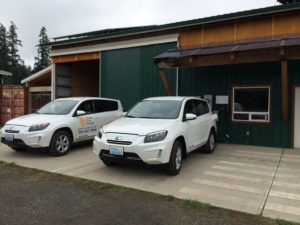
A pair of RAV4 EV’s at Power Trip Energy’s free solar powered EV charging location.
While this sounds good and we look forward to eventually bringing this technology to your home, it is not here now, and may not be here for a long while. In the meantime, your grid-tied solar PV systems will be making clean power and saving you money every month without using your EV’s battery. We just added a second EV to our company’s fleet, a new 2018 Nissan Leaf, which came with 2 years of free electricity when we charge at any EV stations in one of four networks, two of which are common here on in Western Washington – Blink and Charge Point.
Nissan seems to be a leader in V2G innovation in Europe and Japan currently as mentioned in this article from last autumn. https://electrek.co/2017/10/04/nissan-ev-ecosystem-free-power-leaf-vehicle-to-grid/ I notice that the images in most of these articles are still digital mock-ups at this point, not actual installation photos. Also notably, I have not seen recent developments along these lines in the US.
I first saw this concept encouraged by Amory Lovins in the late 1990’s, so we have been looking forward to this functionality for a long time. The concept brings up several questions for me. There are three main uses for large grid-tied residential scale battery banks – one is for emergency back up power in the event of an outage, one is to provide utility dispatchable power for peak load shaving, and the third is for “self-consumption” on a daily basis in order to shift the timing of when a home with grid-tied solar uses that energy.
In regards to the first possible usage, as back-up power during an outage, I would like to see how the controls would work. What if I would rather have a full battery in my car than use that energy for my home? What if I just got home in the evening with a nearly empty car battery when the outage occurs? Ideally the next day would be sunny, and the power from my pv array could both charge my car battery and provide some power for my house. How would I prioritize that energy use – would I rather fully charge my car battery first, then make excess available for home usage? Realistically, I think we are quite a ways from having inverters, chargers, and controls ready to address those questions satisfactorily. However there is probably no technical reason why those could not be solved, though there might be a little complexity on the client side to make certain it works the way you would want.
Regarding the peak load shaving for utilities, this is not something on the horizon at all here in Washington State to my knowledge. There are however several markets where utilities may compensate customers for being able to access their stored energy and use it across large distributed areas in order to prevent the need to fire up a gas “peaker” plant during moments of highest load. This is the case in some markets, where there are commonly peaks on hot weekday afternoons when industry is functioning and also there is a need for air conditioning. In this case, these batteries are not available for emergency back up power. It would be an interesting question as to when I would want to make my car battery (and therefore my driving range) available to the utility, and how much I would let them use, and how much that would be worth to them and me. I think answering these questions is the experimentation being done by Nissan in these projects I have read about in other countries. Again there is no work being done along these lines with V2G in the US of which I am aware.
In the third case, the use case for batteries is a function of the utilility policy that may no longer allow new grid-tied pv systems to feed energy back into the grid (as in Hawaii currently) or rate schedules where there is a strong price signal discouraging customers from sending their solar electricity onto the grid during sunny hours (as in some California markets currently.) We do not have these pricing signals in Washington State currently. These markets are primarily the ones being addressed by the residential-scale wall-mounted “Power Wall” batteries being made by Tesla at the moment, but nobody is actually doing anything beyond thinking about using vehicle batteries for this in the US at this point. There are technical challenges and control system complexities, but I am guessing they will all be solved eventually, though quite a while from now. I look forward to combining these systems with our roof-mounted solar pv systems some day.
The reason why it seems there is no progress on V2G in the US at this point is complex and may be political rather than technical. I sometimes wonder if it is because utilities and oil companies hold greater influence over electrical and building codes in the US than in other countries. Will we see Vehicle to Grid innovation here in the US soon? I don’t know.
Today the price of solar is lower than ever before and we have several excellent state and federal programs to help defray those costs and improve the economics of these upgrades to our clients’ homes. The solar PV arrays we are installing now have 25 year warranties guaranteeing they will still be producing 92% of their originally rated power at 25 years, so there is little doubt that many of the solar pv systems we are installing now will eventually be integrated into storage solutions with wall-mounted batteries and EV batteries that will provide for back-up power and possibly shape the timing of loads that make sense for both our clients and the utilities.
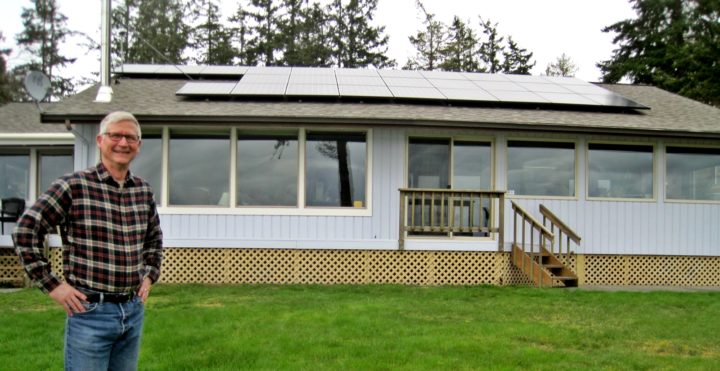
Jefferson County Residence, 9 KW SunPower AC Modules, January 2018
by Andy Cochrane | Apr 17, 2018













